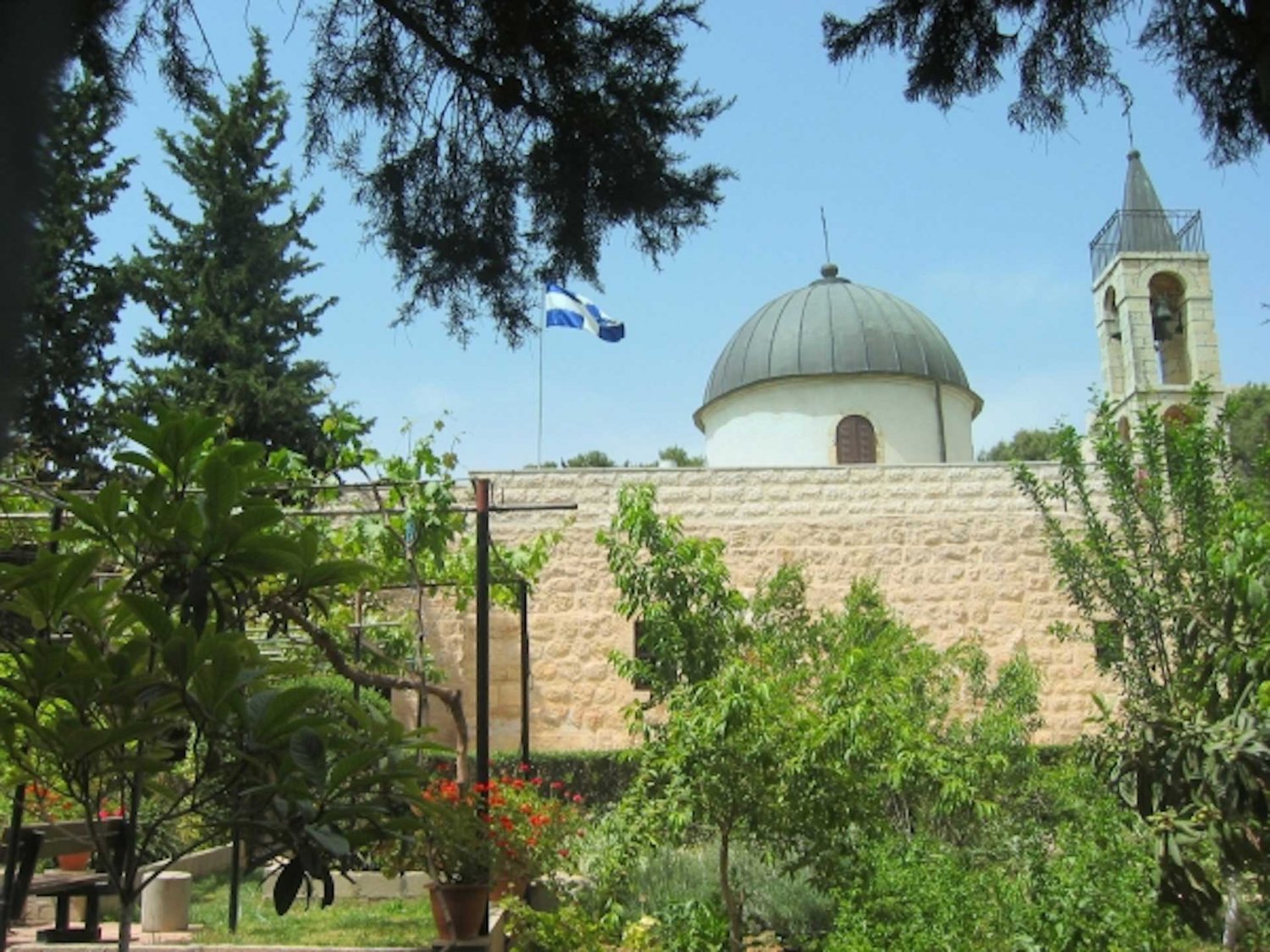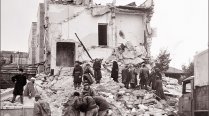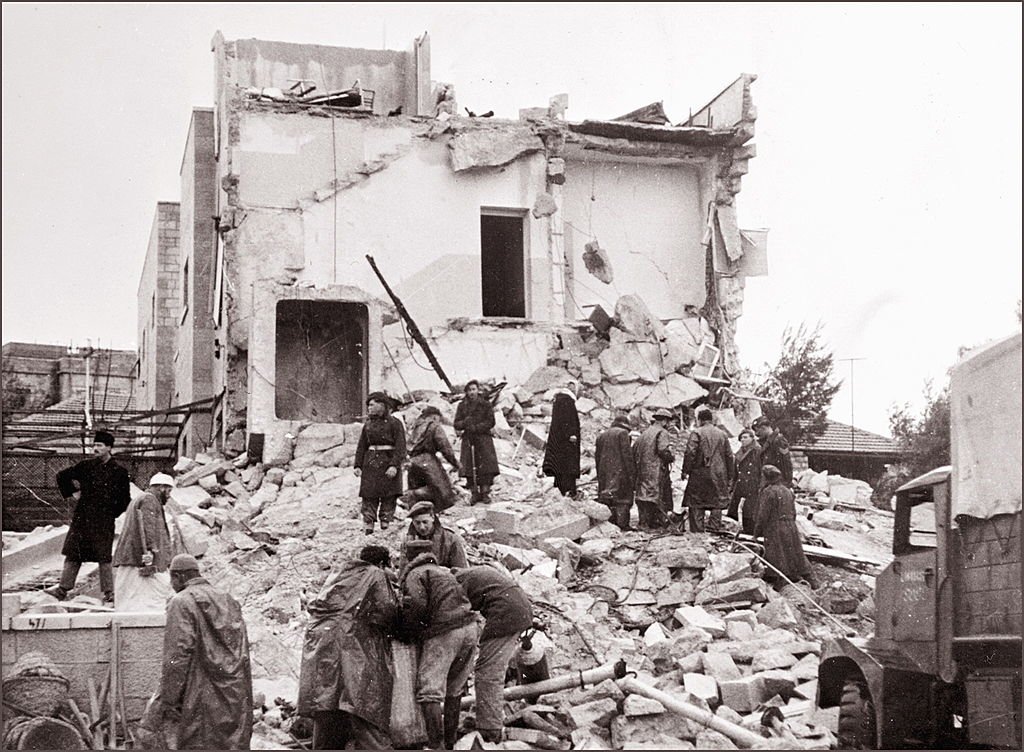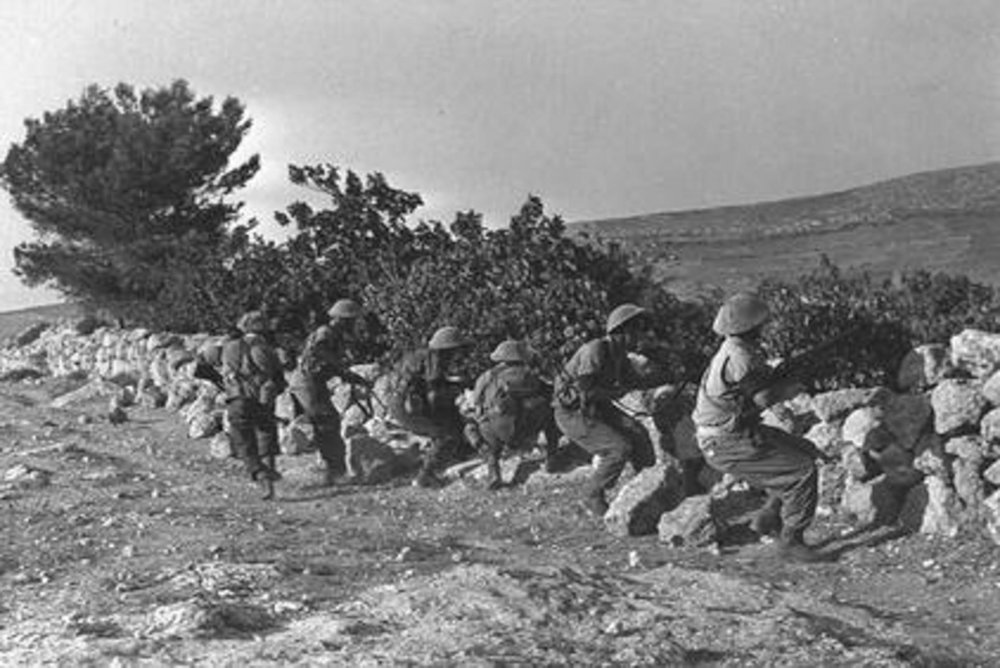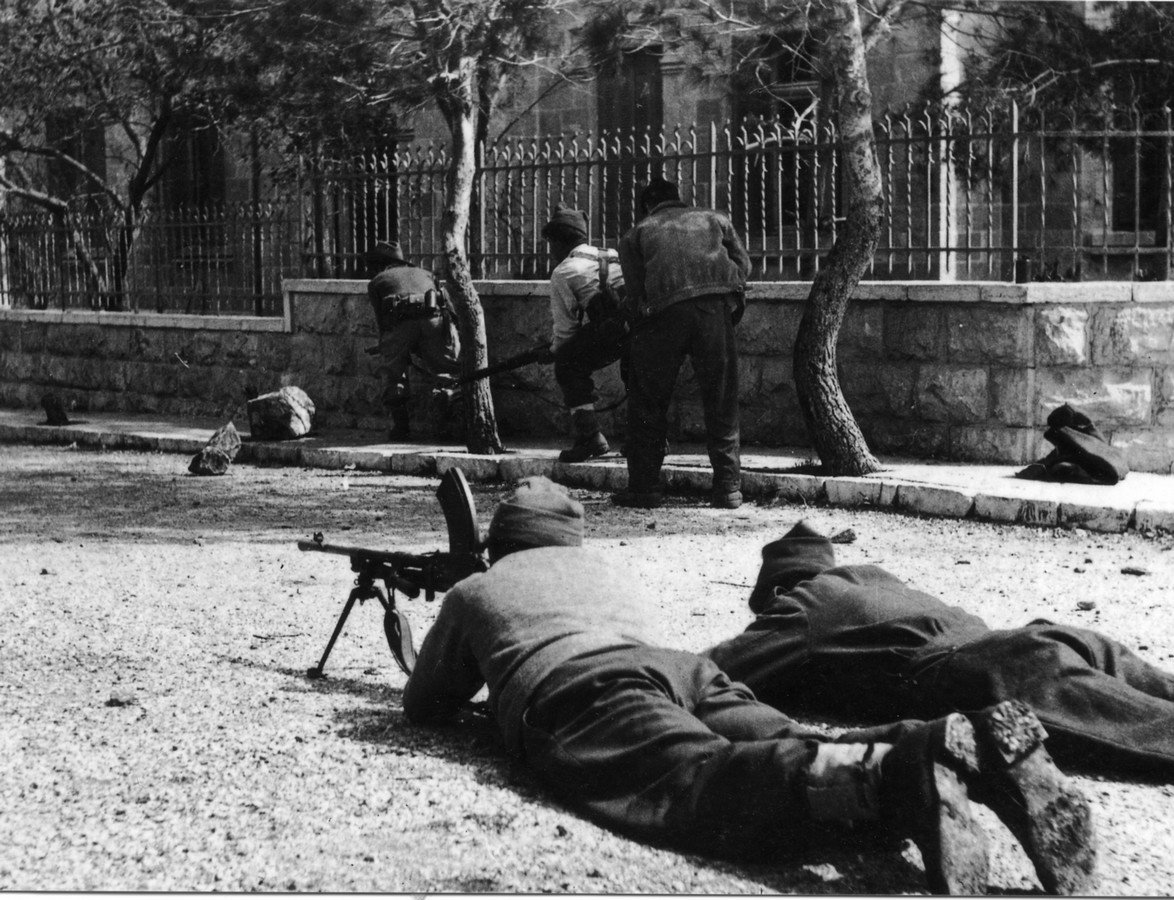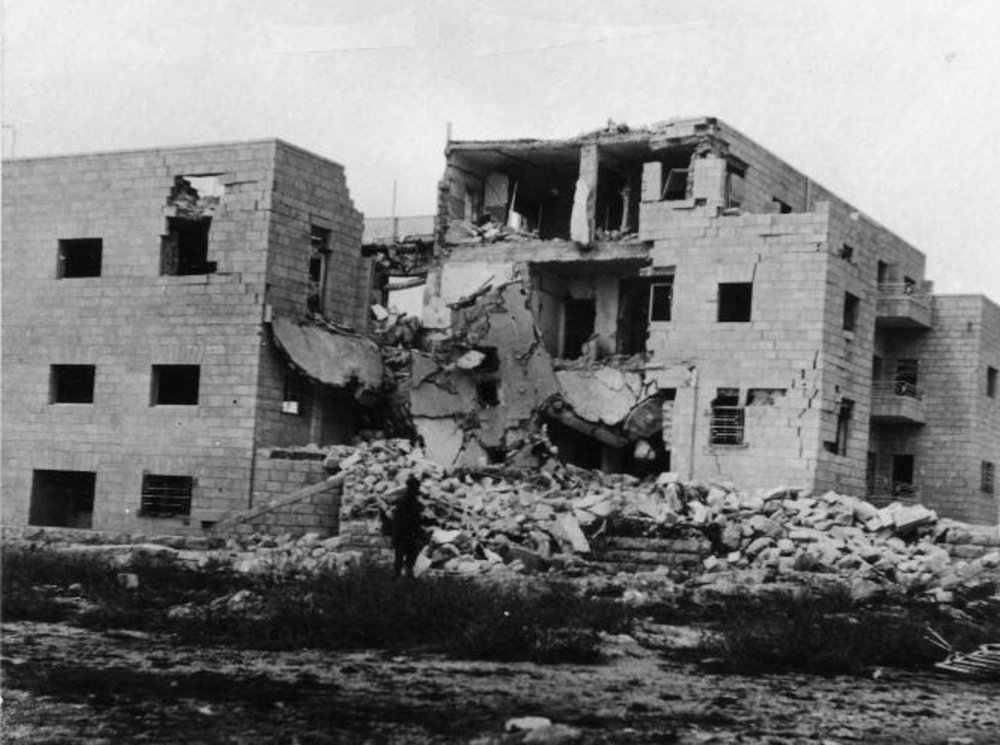Introduction
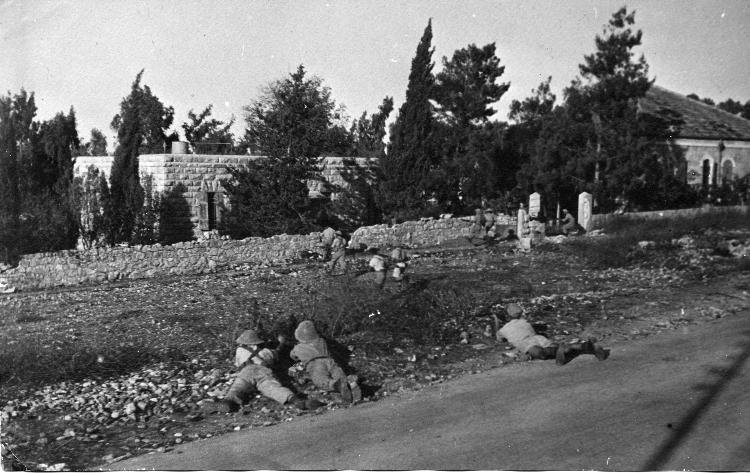
Source:
The Day of the Long Night
Snapshot
Excerpted from Jamil I. Toubbeh, The Day of the Long Night: A Palestinian Refugee Remembers the Nakba (Jefferson, NC: McFarland & Company Inc., 1998)
Jamil Toubbeh was born in Qatamon, the eighth of 10 children born to Issa and Maria Toubbeh. Issa, known as Abu Michel, was the Mukhtar (the chosen head) of the Eastern Orthodox Christian Arab community in Jerusalem. He bought the property in Qatamon in about 1922, attracted presumably by the wave of building in the New City that started around that time in the wake of the British occupation of the city.
On his father’s side, Jamil was descended from a long line of Jerusalemites, dating back at least to the 1800s. Jamil’s nephew, Abu Michel's grandson, Michel Moushabeck, has written about him:
My grandfather Issa Toubbeh (1882–1972), known to everyone as Abu Michel (father of Michael), was the Mukhtar (literally, the chosen), the head of the Eastern Orthodox Christian Arab community in Jerusalem, whom he dutifully served for over 50 years, as his father had done before him and his eldest son after him. As Mukhtar, after the Nakba, he was given a residence inside the Greek Orthodox Convent, which consisted of several large, high-ceilinged rooms abutting the walls of Mar Ya’coub (St James’ Orthodox Church) and the Holy Sepulcher, located on the Convent grounds.
Everyone spoke highly of my grandfather, the Mukhtar, and his important role in Palestinian society. His tenure as Mukhtar and his accomplishments in life would indicate that he was a social activist. Abu Michel was quite erudite and always commanded people’s attention and respect. He spoke fluent Arabic, Turkish, Greek, Armenian, and Russian. And he could even swear in English—with a posh British accent, nonetheless—something he picked up during his numerous dealings with the British before their departure from Palestine in 1948. He survived the rule of the Ottomans, the British, Hashemite Transjordan, and Israel, and was considered a shrewd and highly experienced problem-solver—a necessary prerequisite for the job of Mukhtar. His reputation as a successful mediator spread beyond his flock in the Eastern Orthodox Christian Arab community and his services were highly sought after by people in the Muslim, as well as Jewish communities in Jerusalem. It was also rumored that whenever my grandfather accompanied an entourage of men assembled for the purpose of asking for a girl’s hand in marriage, it was guaranteed that their request would be granted.
My grandmother’s maiden name was Maria Balsam. It is assumed that her great grandmother originated in Anatolia (modern Turkey) when it was part of the Byzantine Empire (Greco-Roman). My grandfather met my grandmother in Crete when he was stationed there as a soldier in the Ottoman Army. She was 13 years old when he asked for her hand in marriage and took her back with him to Jerusalem.
The Mukhtar owned two properties in the Old City, a house and a café called Qahwet al-Mukhtar, where Palestinian literati of the time gathered. He purchased the Katamon property post World War I, around 1922 after the landing of the first British Commissioner (Samuels) stepping on Jaffa’s terra firma. It was originally a barn, a concrete block structure, before it was expanded and converted into a house.
With the exception of Almaza, Michel, and Elaine, who were born in the Old City, all the other Toubbeh children were born in Katamon. The Toubbeh family lived in Katamon for at least 26 years. During the Nakba, the residents of the Katamon district were forced to leave their homes. That’s when Issa Toubbeh, being Mukhtar, was given residence in the Greek Orthodox Patriarchate in the Old City.
The names of Issa and Maria Toubbeh’s children (7 females and 3 males) in the order in which they were born are: Almaza, Michel, Elaine, Fadwa, Mitri, Sonia, Widad, Jamil, Hala, Hiyam.1
Below we excerpt relevant portions of Jamil Toubbeh’s memoirs. They have been abridged and reordered as indicated.
From Chapter 4, “Before the Nakba” (pp. 65–80)
My great-grandfather, grandfather, and father were born in Jerusalem, Palestine. On my mother’s side, the only person who may not have been born in Jerusalem was my grandmother. Presumably, she was the adopted child of Greek parentage.2 The Greek community in Palestine, particularly in Jerusalem, predates the Muslim conquests.
My family had been active in the life of Jerusalem, even during the brutal Turkish occupation. In the early 1800s, my great-grandparents on my father’s side owned property in Gethsemane, adjacent to St. Stephen’s Gate. Like many other Palestinians of that time, they survived on the products of their land—olives, vegetables, and dairy products.
In the late 1800s, large numbers of immigrant-pilgrims arrived in Palestine. Possibly with the view to an easier life in the city my grandparents moved to the old City, settling in a section called Saaha, adjacent to the Christian Quarter. This community served as host to the large number of Russian and Greek Eastern Orthodox pilgrims. As mukhtar of the Eastern Orthodox community, my grandfather performed many of the civil and ceremonial functions that my father and my brother would later perform.
Following World War I, my parents acquired a piece of property near St. Simeon’s Greek Orthodox Monastery and Church. St. Simeon’s was then the only structure in Katamon. The absence of paved roads and transportation imposed certain hardships on the family, alienating it from the amenities of the old City—proximity to schools, work, shopping, and friends and relatives. This period of isolation was, however, short-lived.
According to family history, the 1920s and 1930s were witness to an unprecedented building boom in Katamon and its environs, Talbieh to the north and upper and lower Baq’a to the east. Christian and Muslim families began to build homes in the “Katamon Quarter,” which later evolved into the “Flower Garden of Jerusalem.” The Quarter and its environs soon became magnets to some of the most renowned Palestinian intellectuals and educators. Living within a few yards of our home was Sami Hadawi, political leader, historian and author; Khalil al-Sakakini, educator, author, and poet; Ibrahim al-Khoury, educator and cofounder of an-Nahda College, a progressive high school of Middle Eastern renown; the poetess Fadwa Touqan, and the musician-painter Tewfiq Jawharieh, among others. Much later, Talbieh would be the birthplace of the internationally renowned Edward Said, of Columbia University. His Majesty’s government, perhaps heartened by the “nytive” [sic] community’s civilized behavior, build its exclusive British Club adjacent to it, making the community accessible by motorcar. At the time of my birth, Katamon, Talbieh, and Upper and Lower Baq’a were developed and settled. The only development of consequence during my first decade of life was the emplacement of major foreign embassies in Katamon and Lower Baq’a.
Years later, on a visit to Katamon, I was touched by the everlasting Palestinian character of the “Flower Garden of Jerusalem.” Despite its population density and its overwhelmingly European Jewish population, it has retained its Palestinian ambience. My parents’ small house, my birthplace and home of my formative years, had been bulldozed. The plot on which the structure had stood for more than a century was, unfortunately, a developer’s dream and a historian’s nightmare. The house had been one Palestinian’s vision of a future Palestine—a landmark that, today, might link the past with the present for young Jews who otherwise might forget Menahem Begin’s achievements as a terrorist and a statesman. Fortunately, I did not mourn the destruction of the house. How can one grieve the loss of one historic site when secular and religious Jewish leaders celebrate the bulldozing of hundreds of ancient Arab villages to re-create a state in their convoluted biblical image? In a morbid, poetic sense, I was glad that the house had been demolished. I would not want anyone to relive or remake its history. Just as I retain the memory of the house, so also do I retain my past.
Despite its elitist flavor, Hala Sakakini’s description of the Jerusalem and the Katamon where I lived is accurate.3 Her chronicles are written in the style, spirit, and tradition of her father, Khalil, a frequent visitor to our house in Katamon. Puffing on their narguilehs, he and my father exchanged thoughts on various topics. The Sakakinis and their friends had a considerable impact on my life. I was never fond of the elder Sakakini; arrogant and often pompous, he was, however, a model for many Palestinian youths, and I relished his biting humor and double entendres.
Although the 1930s were years of instability throughout our land, the community in which I spent my first decade was cohesive and supportive and valued children and their education. If I had lacked this extended family, my preteen years could have been wretched. At the time, the ambivalence of British policies over the status of Arabs and Jews was confusing, creating a psychological chasm between Palestinian Arabs and the British, on the one hand, and between Palestinian Arabs and Jews, on the other. This ambivalence did not escape the listening ears and watchful eyes of the young. The riots of the 1930s, justified in light of increased Jewish immigration to Palestine, and the brutal British reaction to them were discomforting and shocking to children.
My first day at Terra Sancta College was preceded by a week of preparation and conditioning. My long hair needed a trim for the occasion. I had to be dressed, at least for the first week of school, in unpatched clothes, tailored by my mother. I had to be accompanied by older children, and someone had to ensure my safe return. “Deer baalak ’aley, bihyatak” (Take care of him, I beg you”), said my mother to the older boy.
“Tkhafeesh ’aley, ya Im Michel” (“Don’t worry, Mother of Michael”) . . .
From Chapter 1, “Katamon” (pp. 9–33)
I was barely seventeen when my father finally decided to move the family away from one of Jerusalem’s zones of terror. It was in November 1947. The steep hill overlooking our Katamon residence was a haven for snipers, surely cordoned by the European Jewish inhabitants of the “Boobs,” the nickname given to the two massive, pink stone structures on the top of the hill. The snipers could fire above the Swiss Consulate into the heart of Katamon and beyond. Every morning, I would look through the black-and-gold lace curtain of our living-room window toward these buildings, hoping to see them in flames so that I could walk in peace to Terra Sancta College, my high school. The red-and-white Swiss flag above the consular building was always flying, always signaling hope. At the time, I did not know that our country and its people were being transformed into mythical beings by the fathers of Zionism and the protectors of our land, the British. I did not know that within months, the entire Palestinian population, except for a small minority of Jews, would become personae non gratae. Most shockingly, I did not know that we were about to be forced to relinquish many centuries of cultural evolution, our culture to be replaced by alien cultures of immigrants from the ghettoes of Europe, the United States, the Soviet Union, and the rest of the world . . . .
We moved from Katamon in stages, each stage defining a mental state, a mindset—fear, helplessness, waiting, hope, or a desire to negotiate, to make peace with someone, anyone, a concept well ingrained in the Arab psyche. We always returned a day later to pick up or return clothes or to fetch food from our deserted house. The nights at my married sister’s apartment were either unpleasant or downright horrid, except when the neighbors’ girls, as frightened as they were, slept beside us, or when someone brought knafeh, a Middle Eastern delicacy, from the Old City. Throughout this time, lasting several months, we did not venture into the British security zone, the barbed-wire boundaries of which blocked the entrance to our house and separated us from families, neighbors, and friends. When British soldiers stretched the first coil of nasty, rusty-brown wire down the middle of our main thoroughfare, my father objected, then quickly realized that negotiating with the British, at war with the Jewish organized gangs, would be futile. He may have concluded, as would any one else faced with the inevitable, that the barbed wire was in our best interest.
We lived with this impediment. As children, we invented and played games across the wire, the learned to harass the British . . . .
* * *
Insecurity in Katamon and elsewhere in Jerusalem became the overriding psychological barrier to daily activities. Children were also affected by this barrier. Moving back and forth from predominantly Arab to predominantly Jewish sectors of Jerusalem, where a number of schools were located, became a game of Russian roulette. In addition to the difficulties imposed by an ill-defined but very real danger, our daily routines required constant realignment and sometimes became simply impossible. It was not long before my sisters dropped out of school, temporarily at first and then permanently. I continued to attend school, protected by older students. Although most sections of Katamon were relatively safe, venturing beyond Katamon’s boundaries became dangerous for everyone. As children in the late 1930s and early 1940s, we had disappeared into horizons of wheat fields, vineyards, fruit orchards, or railroad tracks and then, like bees guided by internal sextants, had headed home in time for dinner. This freedom of movement and trust in the community vanished overnight.
In the open spaces of Jerusalem of the mid-to-late 1940s, the angels of death lurked like vampire bats, waiting to strike at their human targets. Here and there, groups of Palestinian Arabs or Jews set up their own miniature “zones of terror” to harass or kill anyone passing through or near their respective domains. On busy mornings at Jaffa Gate, Jewish gangs tossed grenades a innocent shoppers before disappearing into their nearby communities. We heard the explosions in Katamon. Their contributions to inhumanity were displayed on the front pages of newspapers the following day. . . .
The Jewish gangs, far more experienced than their Arab counterparts, set the pace and conditions for Arab-Jew encounters. Even I was threatened by knife-wielding Palestinian Arabs, at Jaffa Gate in Jerusalem’s Old City. Had it not been for the timely appearance of my father’s friend Khalil, I would have been knifed by the angry mob. In khaki shorts, I did not look like an Arab teenager; therefore I was game. I survived the ordeal only because of the inquisitiveness of Khalil, who recognized me and yelled, “Jamil, what are you doing here at this hour?” The hour was five o’clock in the evening. I was delivering my mother’s message to my father to buy groceries for the next day. During these difficult missions, I often saw the consequences of the skirmishes between small groups of Jews and Arabs—limbs of bodies that had lost their human relevance, trophies of war that had far less significance than the carcasses of sheep hanging on hooks in Jerusalem’s butcher shops. It is so easy to look back and track the course of events in Palestine, in Jerusalem, and in Katamon. It is so easy to hate, dehumanize, and to kill, and so difficult to resurrect memories of love.
I am fortunate to have survived the sharp edge of the knife. I still remember its shimmer and its cold touch. It is a perpetual dream, one that always fades into the face of Khalil. I wish my father’s protégé had survived. My father’s face would have been in his dreams too, and perhaps the Jewish state would have had one more rational mind.
There was so much paranoia during these early days preceding the establishment of the Jewish state that venturing into certain parts of Jerusalem was impossible. Following the incident with my own people, I began to wear a beret in the predominantly Jewish part of Jerusalem and a kaffiyeh in the Arab part. The ploy was insane, but it worked.
My father was right; we did not stay long at my sister’s apartment. A Muslim family had left the British security zone adjacent to our house and had offered their home to us temporarily. We could have had many such houses. This was a time of extreme generosity and tolerance among Palestinians. Families and strangers found themselves trapped in unusual places and circumstances. Towns and villages swelled with newcomers and temporary refugees, fleeing real or imagined dangers. The affluent few made their vacation spots their refugee places: Beirut, Damascus, or Alexandria and Cairo. We were not braver than they; we simply did not have the means to move farther than a few miles, the longest and most painful historical miles, ever traveled by this Jerusalem family.
The temporary new home was an old, beautiful, two-story stone house, surrounded by tall pine trees and protected from sniper fire on all sides. Far more spacious than our own house, it reflected gracious living. It was not far from my sister’s house, but since it stood in the British protected zone, we were required to have a special permit to reside in it. The house was across the street from the oversized Czech consulate and the tree-shaded, exclusive British Club, with its soccer, hockey, cricket, and polo fields. The family who had vacated the house had left everything intact, including their gold jewelry. Just like everyone else, they intended to return soon to reclaim their home and property. We were all oblivious of the laws the new Zionist state was about to enact, laws that would dispossess Palestinians of home, land, and identity.
At the time of our second move, families in large numbers were making similar if not more serious moves. Toward the end of 1947 and during the first few months of 1948, no one in Katamon spoke of departure, even when departure was imminent. Indeed, children were aware of the need for absolute secrecy for fear of being labeled cowardly. Nevertheless, everyone was aware that the Katamon community was on the verge of collapse, not due to cowardice but due to inexperience in armed defense.
My father, being the elder in the community, did not want to precipitate the exodus of family members or close friends in Katamon, despite our house’s vulnerability to sniper fire and night attacks. When we did finally leave, the departure was painful. In the end, however, only the hardiest remained behind in Katamon, and even they reappeared, many months later, in the territory that had become a part of Transjordan. A classmate told me a year later, in Jericho, that Katamon and its surrounding territory “were occupied by Jews with minimal resistance.” He did not know the fate of other families. “My family and I were forced to leave our hostel-home at gunpoint . . . then transferred to Transjordan as prisoners of war. They did not allow us to take anything.”
I cannot recall how many times we returned to our home or to my sister’s apartment to fetch things or feed the animals and birds. My mother, accompanied by one of my older sisters, would trek to these places secretly to ensure their continuing habitability and survival in the event of a sudden return. My father, never a homebound creature, adapted easily to these temporary annoyances, but they bothered the rest of us. We missed our home, our friends, our neighbors. I still wonder what happened to our fancy pigeons, the chickens, the rabbits, and our resident pheasant. My father swore that they died of fright, adding humorously, “Who would not, seeing Menahem Begin’s or Golda Meir’s face at dawn?” The majority of the animals probably turned wild, except for the pets—two dogs and a cat that sucked its tail. They, like us, braved the sound of machine guns and bombs without antidepressants.
The Jewish terror gangs made sure that the Arab residents of Katamon slept little and most uncomfortably. Katamon was on their hit list. A week before we moved to my sister’s apartment, the donkey that carried fresh goat milk to a few Katamon residents was shot by Jewish snipers “right through his arse,” according to its farmer-owner, Mahmoud. “They did not shoot me,” he told my startled mother. The Jews did not want to kill him; their aim was to disrupt the lives of Katamon’s inhabitants and to spread tales of horror among them. Mahmoud’s story was heard in every home within surrounding neighbhorhoods. I was sorry to see him wave goodbye to us for the last time. I was sorry to see the other peddlars leave, too. Their faces were the faces of Palestine, its beauty, innocence, humor, history, culture, religions—its soul.
The donkey’s carcass, burdened with undelivered milk, laid claim to Katamon’s famous ’Abdeen’s Circle—location of several embassies—for a full day, then disappeared. A British soldier hauled it away on a tank. It deserved a dignified funeral, my brother-in-law noted. “The British love animals more than they do humans. If they have so much love as to shoot their aging dogs and bury them on Palestinian soil, why not treat an indigenous martyr ass with equal reverence?” I agreed.
It was the reclusive and elusive Mrs. Harris, we learned later, who alerted the British rescue team to the demise of the donkey. That stuffy, skinny, pucker-lipped neighbor, so fond of animals, was oblivious to the Palestinian tragedy unfolding before her. Were it not for her intervention, the carcass of Mahmoud’s donkey would never have been removed. To her, the death of a donkey was more than a diplomatic affair; it was an environmental issue. Burying the donkey in style not only would reflect English empathy with its owner but also would keep the streets of Katamon, the “Flower Garden of Jerusalem,” clean.
A short time after Mahmoud’s experience, the Jewish gangs struck two destructive blows at the Katamon community. Their intent was to keep the community so on edge that its inhabitants would cease to function rationally. Little did these gangs know how ill-prepared we were to defend ourselves against any kind of armed attack. Or perhaps, they did.
On a dark, cold winter night a gang of Jews bombed Hotel Semiramis. Winters in Jerusalem were, and still are, particularly harsh for families dependent on kerosene heaters, as we were. The danger of noxious fumes was ever-present, as we learned one year when one of us inadvertently closed two ventilation windows. Anxiety over family safety heightened winter’s mischief, prompting my father’s perennial comment, “When I die, I hope it is not in January or February . . . because I would choose hell over heaven.”
When Hotel Semiramis was bombed in the winter of 1948, we were all at home. My brother Michael, just returned from Libya, was also with us. We were roused by the sound of thunder, then by the sound of machine guns. The explosions were accompanied by lightning and thunder. It was difficult to differentiate between man-made noise and nature’s violent outbursts. The attackers were not unaware of the relationship. They used the cover of nature to slaughter dozens of residents of the hotel. The blast, originating in the basement of the hotel, was disproportionate to the size of this magnificent white stone structure. My uncle, less than a quarter of a mile away, was awakened by the crash of a picture window against his bedroom wall. Elie, a teenager and a member of my family living in an apartment next to the hotel, was so terrified that he remained frozen in the fetal position hours after the blast. The young children of the proprietors, the sole survivors of the family, knelt in prayer amid the carbonized rubble. British soldiers, at the scene within minutes, were nearly helpless. They were poorly equipped for a rescue operation of this magnitude. A guard assigned by the Katamon community to intercept strangers prowling through its streets was killed by a sniper’s bullet. His two shots aimed at the retreating Semiramis attackers had instantly signaled his position to snipers.
For the next five days, all attempts at removing the survivors failed. There were neither cranes nor bulldozers but only brawn, unaccustomed to mass destruction. I remember the British coming and then leaving, their departure coinciding with the death of the last survivor, whose agonizing cries finally ceased. My brother Michael, then a reporter for al-Kuds, subsequently wrote a piece about the disaster. The Jewish sackers and thugs visited Katamon often after that incident. They had a plan as per Menahem Begin’s memoirs: Katamon would be an outstanding example of the horrors associated with Jewish organized terrorism in Palestine.
The Semiramis explosion, the trigger for the on-again, off-again migrations from home to home and for the final exodus of Katamonians from their homes, was a microcosm of the larger explosion that would reverberate throughout pre-Jewish Palestine. In retrospect, I realize that “our dining room,” to which we were always headed when we were under attack, was so vulnerable that no one would have survived a single grenade tossed through the room’s west window. But in our minds then, it was safe. Even my sister’s apartment, as vulnerable as our house, was deemed safe. All over Palestine, Palestinians were creating psychological safe havens, secure zones, and bonds of friendships to tide them over until their return. Al-’Owdah, the day of return, was always tomorrow, the following day, or at worst, within a few weeks. The date was never measured in months or years. It still is not, fifty years after our diaspora. Even I have not lost hope of reclaiming my birth place, the small house that the Jewish state’s leader ordered bulldozed to make space for a multistory apartment complex. While the Jewish state has meticulously guarded the graves of its fallen, it has demolished the place where most members of my family were born, where Palestinians have been for generations, and where they are born today.
For several weeks following the bombing of the Semiramis, my family was on edge. At night, the slightest sound sent us running in terror to the dining room. The young huddled under the large dining table while the adults catered to their basic needs—water and a potty. The white porcelain potty, crackled and crazed, was passed from child to child like a salad bowl, engendering loud, nervous laughter. With the shutters closed, my mother would light a candle and hand it to one of us crouched under the table. Blankets followed. Within minutes of the crisis, my brother Mitri would let out a “big one” to interrupt the silence, and all hell would break loose. He was well-known for breaking the ice.
During those times, one of us invariably told a story or a dumb joke that carried with it the penalty of unending criticism, further contributing to loud laughter. My father caught the brunt of most political humor because of his unflinching support of England. “Ksouz me, father, how’s your king today?” one of my sisters would ask from under the dining-room table or under a bed. We had taught him to use the words “excuse me” before belching in the presence of guests, and it had transliterated to “ksouz.” The royal reference was a lampoon of his devotion to King George V, long deceased. Often, he confused Number V with Number VI.
The dining room, our haven in times, of crises, was the all-purpose room and the staging area for my father’s Anglophilic propensities. My brother Michael’s four-poster bed was there. Mitri’s and Sonia’s beds were also there, doubling as benches for the young and the old while dining. We all shared those beds, but Michael’s was the apple of discord, particularly during his frequent absences. The bed was not only the most comfortable in the house but also the last likely to collapse under its user. My parents’ bed was the worst and was the cause of much embarrassment whenever it collapsed under its occupants during sexual acts. The crash nearly went unnoticed by the older, savvier family members. As a child I thought beds collapsed routinely, a sort of built-in flaw to facilitate their handling. By the time my sexual intellect had matured, such crashes were being upstaged by more powerful crashes, ones that did not generate humor.
* * *
When the newly completed and as yet unfinished white stone Shaheen Building on the edge of western Katamon was hit by Jewish gangs, any residual hope we might have had of staying in our own house was shattered. The building overlooked the valley that led directly to Ein Kerem, a picturesque old Arab village. The bombing of the Shaheen Building, followed by other bombings to the north and northwest of Katamon, ended our communication with the people of Ein Kerem and adjacent villages. The “Question of Palestine,” debated at length in the UN at the time, was rapidly being translated into the “Question of the Zionist State” by Jewish gangs. The word “Haganah,” the army of the future state, was beginning to surface in the media. Brutal as the infamous Stern and Irgun Zvei Leumi gangs, this “army” was being touted by Zionists and their apologists as a civilized army not involved in massacres of Palestinians. Collectively, Jewish gangs were creating both fact and fiction, regardless of world opinion. Zionism was presenting the world with a fait accompli, despite UN resolutions and international law. It was forcing the world to honor its terrorist leaders, Yitzhaq Shamir and Menachem Begin, on whose head Britain had $40,000. Some years hence, the queen of England would bow to these terrorists-turned-statesmen, saving them from England’s fatwa.
Under our dining room table, in the dimness of a candle, I failed to fathom the enormity of the rapidly unfolding Palestinian tragedy. I was glad Michael was at home, not away on one of this “secret missions”—with banat il ajanneb, the foreign ladies. I was not happy to see Mitri, my second elder brother, suffer recurring grand mal seizures. These tense days and weeks played havoc with his emotional life. In a way, however, he was the luckiest among us: When he awakened from his neurological meanderings, he rarely recalled anything.
We left our second refuge home toward the end of the spring of 1948. The effects of displacement were beginning to take their toll on all of us, but especially on my mother. The day before our departure was devoted to cleaning the house and separating our belongings from those left behind by the owners. The change in my mother’s demeanor was obvious: her usually vibrant voice was subdued. My eldest sisters, Almaza and Helen, swept and cleaned the floors silently. Outside the house, in the shade of the evergreens, my father negotiated with porters to haul our meager belongings to the Old City. The porters were at the house early that day, their donkeys tethered an aesthetic distance from the garden gate. Buses now no longer ran regularly.
Not one of us wanted to leave the second refuge home. It was still within reach of our own home, a stone’s throw from our cradle of infinite memories. At that moment, it seemed that each one of us was living in a separate and detached world devoid of humanity. Alone, I walked away from that scene to encapsulate, in a glimpse, a priceless past of friends and familiar terrain. I headed toward the British sentry at Zone A for a last look at that past, which would eventually sustain a future in the diaspora. In a matter of hours, I would leave Katamon, my birthplace, blessedly unaware that I would never return.
The young soldier guarding the gate waved at me as I approached his protective wall of sandbags. His polished Bren gun rested on its short, inverted V-shaped stand, seemingly unguarded and unneeded. His loaded Tommy gun dangled casually from his shoulder. I did not see the other soldier, hidden behind the sandbags, undoubtedly pointing his gun at me. Several children played in a depression outside the gate, oblivious of the danger of sniper fire.
The depression, known to us as il jawrah, was one of several in Katamon that filled with rainwater every winter, in the spring, it became a major battleground for mud fights, as well as a spawning habitat for frogs. In a few months, I thought, the depression would be filled with water, the tadpoles giving it life again as they had in the lifetime of my family and all the families of Katamon.
The paved road, leading diagonally from our second refuge home to the sentry, was part of a loop that encircled Katamon. At the top of the diagonal, the road bifurcated, one segment leading to St Simeon’s Church eastern entrance and the other to the Hotel Semiramis and to Katamon’s bus terminal in the west. My thoughts were focused primarily on the church, not because of any religious attachment I might have had for it but because of its symbolism. It was a popular gathering place for the community and a refuge for those who sought the solitude of monastic life in the embrace of nature.
Half a mile away, I could see tall pines reaching far into the sky from their base in the church’s extensive grounds. An innocent white, late-spring cloud hinge motionless over the spiraling pines like a giant kite. To my left, Mekor Chaim, the oldest Jewish settlement in the area, was shuttered and lifeless; on my right, the Syrian, Lebanese, and Egyptian embassies and houses, once residences of British and affluent Palestinians, were now deserted. Directly ahead, a truck carrying four armed soldiers dressed in drab greens had stopped in front of Claridge Hotel. One of the soldiers, with pistol in holster and gesticulating like a field commander, looked toward me and the British sentry as if to warn us of the new order of things. Descending from the truck, he signaled his comrades to follow him while he surveyed his new domain. Through his eyes, I saw again the open space where I, as a child, had hunted for the rare wild cyclamens that hugged the blue-gray rocks around my home. Later, I would learn that the soldier was Ibrahim Abu Dayyeh, a legendary Palestinian who had engaged in battles against the well-armed Jewish gangs.
The British soldier was not fazed by the presence of armed Palestinian men, and I was delighted to see them. They became the instant saviors of Katamon, Jerusalem, and Palestine. For a moment I convinced myself that if these men could expose their weapons to British soldiers, defying authority, they could easily prevent the further onslaught on our community. That kind of fantasy, unfortunately, transfused the Palestinian mind. Several generations would pass before this fantasy was erased.
The walk back to Katamon was my last, and yet a half century later, I cannot remember ever having left my birthplace. I have not yet found a good reason to leave it or, for that matter, to erase Jerusalem or Palestine from my memory.
Notes
Michel Moushabeck, as quoted on the Facebook page of British Mandate Jerusalemites Photo Library, February 8, 2021, with photos.
The Greek community in Palestine, particularly in Jerusalem, predates Muslim conquests.
Hala Sakakini, Jerusalem and I (Amman: Economic Press Company, 1990).

